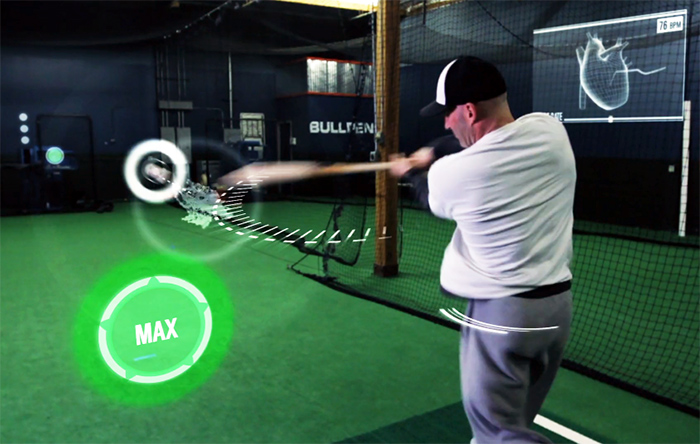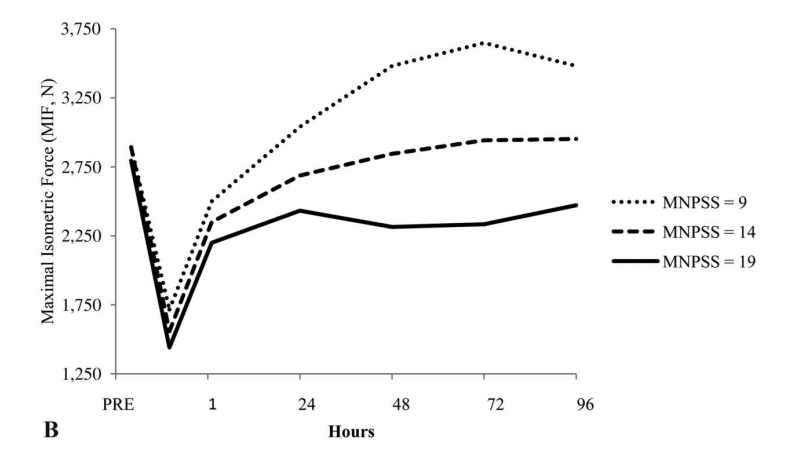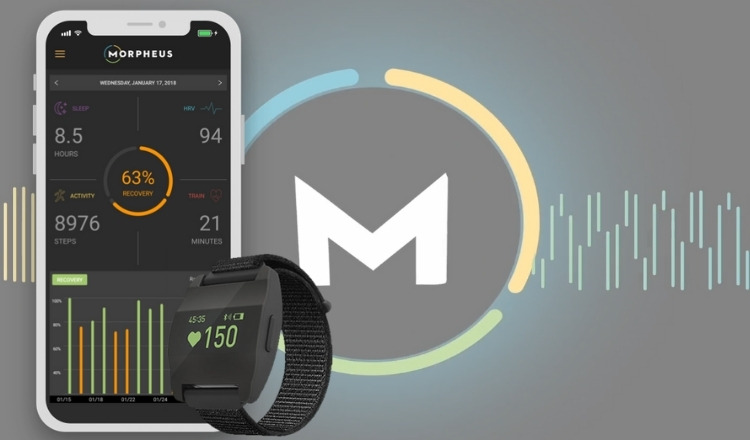
Not long after I opened my gym in 2003, a high-level Microsoft exec came in to train with me. He played recreational volleyball and was only 5’9”, so he was desperate to increase his vertical jump.
After working with him for a month or so, his vert was up a little over an inch. He saw this as a massive improvement because his jump hadn’t improved at all for over a year.
For the next phase, I decided to up the intensity a bit. Things were going well and I wanted to keep him progressing. Another month went by and we measured again.
This time, the results were not so exciting—his jump had actually gone down ½ inch.
I figured it was just an off day and he was still a bit fatigued from the last training session. Undeterred, I kept his program more or less the same and pushed ahead.
The next month, it was even worse. His vertical jump was down another ½ again.
So after three months of training with me, his vertical was right back where it started. He was obviously much less thrilled with his results at this point.
He was frustrated, and so was I. I had to figure out what went wrong.
At the time, I was using heart rate variability (HRV) to track his recovery before each session. This was years before HRV apps, so the only time I could measure it was when he came to work out.
The problem was that he only worked out with me for two or three days a week. I knew I wasn’t seeing the entire picture.
I asked if he’d come by the gym every single day, weekends included, for the next month so I could get more data. To be honest, I didn’t know if this would really help, but I thought it was worth a shot.
Within the first full week of tracking his HRV daily, the reason his vert was going down became obvious. His recovery was terrible.
I just wasn’t able to see it until I’d tracked an entire week of data.
I started asking more questions about his lifestyle to see if anything had changed over the last few months. That’s when he told me he was put in charge of a massive project at work. He was hammering out 60-70 hours a week at the office on top of training with me and playing volleyball on the weekends.
It had never occurred to him that there could be a connection between the his work stress and his vertical jump. But once I saw the full picture of his data and heard how much stress he was under, I knew I’d solved the mystery.
Mental stress was killing his recovery and his vertical jump. I thought testing his HRV before his workouts would be enough to catch and prevent this. I was wrong.
I’ll tell you more about what happened next, but before I do, I want to cover why mental stress is such an important piece of the fitness puzzle in the first place.

Understanding the Recovery Trajectory—Why It’s the Key to Getting the Most Out of Every Workout
The easiest way to understand exactly how mental stress and the thoughts in our heads can change the results we see from training is by looking at a study done by Stults-Kolehmainen et al in 2014.
The researchers led a group of college students through a series of physical tests and categorized them based on their levels of life stress.
Each student then did a 10-rep max on the leg press, followed by 6 more heavy sets.
Over the next 4 days (96 hours), they retested their maximum isometric force (MIF), along with self-reported levels of soreness and fatigue, every 24 hours to gauge recovery.
Looking at recovery every 24 hours for 4 days gives us what we can think of as the recovery trajectory. This is the path that your body takes as it recovers from a workout, or in this case, a fitness test.
The recovery trajectory is hugely important. It’s what ultimately determines whether your fitness improves, stays the same, or even gets worse, as a result of your training.
Think of firing an arrow at a target 200 yards away. Whether or not you hit the target depends on more than just where you aim and when you release.
You could aim it and release perfectly, but if there’s a strong gust of wind, your arrow could miss the target entirely. This is a lot like how fitness works. Your workout is just the trigger—everything that happens after that can throw your results off course.
In other words, it can be the difference between hitting the target and getting the most out of your hard work and missing it completely.
To see just how dramatic this difference can be, let’s compare the recovery trajectories of students with different stress levels (quantified in a Mean Perceived Stress Score [MNPSS]):

The three lines in the graph each represent different overall levels of stress, shown by the MNPSS score on the right.
Students with the lowest overall of stress (dotted line) recovered the fastest and saw a measurable increase in their strength in the days following the test.
Students with the highest level of stress (solid line) didn’t fare nearly as well. After a full 4 days, their strength still hadn’t recovered to where it was at the start.
Finally, you can see that those with a moderate amount of stress (dashed line) took about 3 days of recovery just to end up back where they started. They didn’t lose strength like the high stress group, but they didn’t gain any either.
Think about that for a minute.
All the students went through the exact same assessment and training protocol. But what happened after that was dramatically different based on their mental stress levels.
The question is why?
The Truth About Fitness—It’s the 23 Hours Outside the Gym That Really Drive Results
Most people know that too much mental stress is not a good thing. But they don’t know that it can play such a dramatic role in their fitness. It doesn’t seem possible that mere thoughts can be the difference between making gains, hitting a plateau, and even losing fitness or getting injured.
But the truth is that mental stress can, and often does, have a huge impact on your training results. This is exactly what the study showed, and it’s something I’ve personally seen over the last 20 years of coaching.
There are two big reasons for this:
The first is that any time you’re dealing with mental stress, your body shifts energy away from recovery to handle the perceived threat. This is how the sympathetic nervous system works and why it’s called the body’s “stress response” system.
When this happens, the parasympathetic nervous system (the one that’s responsible for driving recovery) gets turned down. The end result of this pattern is that your recovery trajectory gets pushed downward:

Your body chooses to devote energy to dealing with stress now rather than improving your fitness, which only pays off later. Your energy resources are limited, so your brain has to prioritize what’s most important.
The second reason mental stress is such a fitness killer is because it’s intricately tied to two other drivers of recovery: sleep and nutrition.
How many times have you eaten something you knew you probably shouldn’t have because you were stressed out? Or laid in bed at night, unable to sleep, because something was on your mind?
Too much mental stress is bad enough by itself; but it also drives up hunger and interferes with sleep at the same time, making it an effective recovery killer.
3 Ways to Keep Mental Stress from Killing Your Fitness
Yes, mental stress can kill your fitness by crushing your recovery, but there’s good news: you can stop this from happening to you.
This starts by recognizing that life is stressful. No matter how hard we try, we’ll never be able to completely eliminate stress.
What we can do, however, is actively work to minimize its effects on both our fitness and our health. Just like we put time and hard work into training when we’re in the gym, we need to do the same for recovery when the workout ends.
Fitness doesn’t stop when you leave the gym.
With that in mind, here are three powerful ways you can keep mental stress from sabotaging your fitness.
1. Use HRV to track and optimize your recovery trajectory
When I first started using heart rate variability (HRV) 20 years ago, almost no one in the fitness world knew what it was. Today, there are endless HRV apps and devices, and millions of people measure it each day.
HRV is the single best tool you have to track your recovery trajectory. That’s because it indirectly measures how much energy your body is putting into recovery by tapping into the parasympathetic nervous system I discussed earlier.
(For a primer on HRV and how to improve it, click here to watch a video I put together)
Measuring the variability in your heart rhythm gives you the best overall picture of where your body is on its recovery trajectory. This means HRV can help you gauge the impact of things like mental stress, sleep, nutrition, and more.
That’s why HRV is so powerful when you use it the right way.
What does that look like?
To prevent mental stress from killing your fitness, the most important way to use HRV is to connect the stress you’re dealing with outside the gym to what you should be doing inside it.
When you see a big change in your HRV from mental stress, lack of sleep, poor food choices, etc., adjust your workout to avoid adding even more stress.
A lot of people think it’s a good idea to top off a stressful day with a high-intensity workout. You don’t have to use HRV for long to see that this is actually a terrible idea, because all it does is kill your recovery.
HRV will very quickly show you that physical and mental stress do not cancel each out.
If you’re already using HRV on a daily basis, click here to see my tips on how to get the most out of it.
If you’re not using HRV, make sure to check out my own recovery management system, Morpheus.
2. Use training as a way to develop your stress management skills
When I first started training combat athletes, I thought the best way to help them improve their conditioning was to push them to their mental and physical limits.
A few months in, I decided to start training with them myself and quickly realized how wrong I was!
The athletes who were the best conditioned weren’t the ones training at the highest intensities all the time.
They were the ones doing the most work while making it look easy.
They kept themselves under control. They managed their energy and were incredibly efficient. They didn’t go 100-mph all the time when they sparred in the ring.
They could last forever, while I gassed out quickly—even though I pushed myself hard and thought I was in good shape.
That’s when I realized just how important it is to use training intensity in a totally different way.
Instead of trying to get the fighters to drive their heart rates to the max, I started having them focus on controlling their heart rates.
I wanted them to push themselves hard, but manage their energy and stay calm at the same time. This is what I call dynamic energy control, and it’s a skill that can be trained.
In combat sports, this skill is often the difference between winning a fight and gassing out in the first round.
You may not be a combat athlete, but if you want to get better at managing life stress, the most powerful tool you have is the gym. If you can learn how to stay calm at the height of physical stress, while you’re lifting a heavy weight or pushing your cardio, you’ll quickly get much better at dealing with mental stress.
That’s because dynamic energy control is really all about learning how to tap into your stress and recovery systems. And that’s the key to managing any type of stress.
The best way to start working on dynamic energy control is by training with a heart rate monitor. This form of biofeedback helps you utilize a different side of training that most people completely miss.
You can see exactly how I do it by clicking here.
3. Incorporate at least 5 minutes of active relaxation into your daily routine
One of the most important things you can do to reduce mental stress and improve recovery is take a few minutes each day to actively relax.
Why is this so important?
Like anything else, if you want to get good at turning off stressful thoughts and turning up recovery, you have to practice it.
At its core, this is an act of learning how to turn down your sympathetic stress response system and turn up your parasympathetic recovery system.
Practices like meditation, mindfulness, yoga, etc., are all effective ways to develop this essential skill. The concept of turning off the mind and letting go of stress has been around for centuries, because people have long recognized its value for increasing health and longevity.
It’s only recently that tools like HRV have shown us that it’s incredibly important for our fitness as well.
However you choose to do actively relax, the key is to consistently spend a few minutes practicing each and every day. My suggestion is to start with 5 minutes and gradually work up as you start improving.
It might not seem like much, but as little as 5 minutes a day can make a huge difference. I’ve seen it happen time and time again.
Whether you use a mindfulness app or put on headphones and listen to relaxing music, you can track whether your active relaxation practice is working by using a heart rate monitor.
When you turn down your sympathetic system and let go of stress, your resting heart rate will naturally decrease by a few bpm. When you get better at this, you’ll see your heart rate drop faster—you’ll even see it get lower over time.
If you’re tracking HRV, you should also see a noticeable increase in your average HRV as you become more stress-resilient. This is a sign that your recovery trajectory after each workout is likely improving.
How the Story Ends
After seeing just how much impact mental stress was having on my client from Microsoft, I made some changes to his program. At the same time, I had him start working on the strategies I covered above.
With this approach, he added 3” to his vertical jump over the next few months. And he was playing the best volleyball of his life.
As an added bonus, he stopped getting nagging injuries every few months for the first time in his playing career. He stayed completely healthy.
Needless to say, he was a whole lot happier than after the first 3 months!
He ended up becoming one of my best clients and consistently trained with me for the next 10 years. He also referred a ton of other Microsoft employees and volleyball players, which was hugely helpful for getting my business off the ground.
I have no doubt that if I hadn’t made the connection between his mental stress and his vertical jump, the story would have ended very differently.
The problem is that the story does end differently for most people. They never realize just how important mental stress and recovery are. They don’t have any idea that mental stress is often a much bigger limiting factor for their results than their workout.
People spend hours in the gym and hundreds (or thousands) of dollars on coaching, supplements, wearables, etc., and they sweat the details like whether they should do 4 sets of 5 reps or 5 sets of 4 reps.
But what most people don’t do, unfortunately, is invest in the 23 hours outside the gym.
They never work on learning how to reduce stress. They don’t get enough sleep. They live on caffeine and other stimulants. They don’t get enough of the right calories at the right time. The list goes on.
If you want to actually reach whatever your fitness goals may be, the key is to train, allow yourself to recover, and repeat. Over, and over, and over again.

